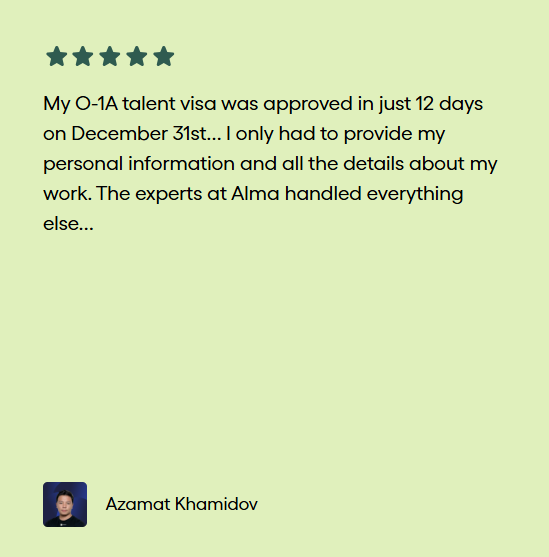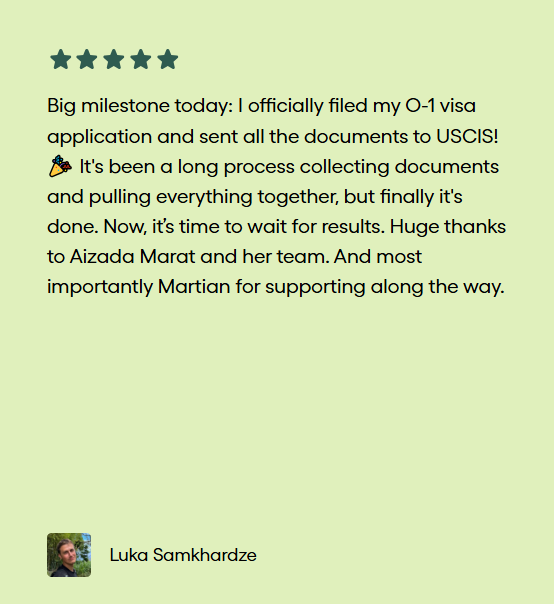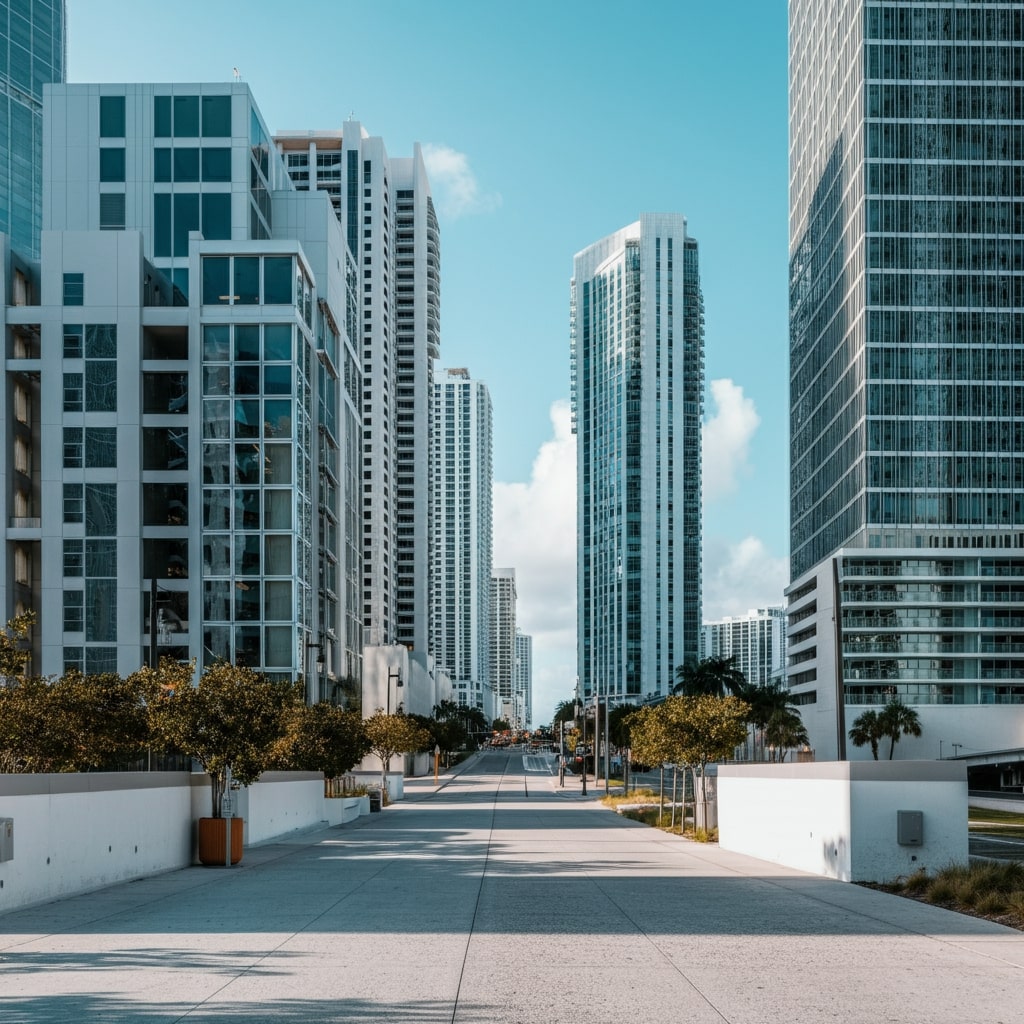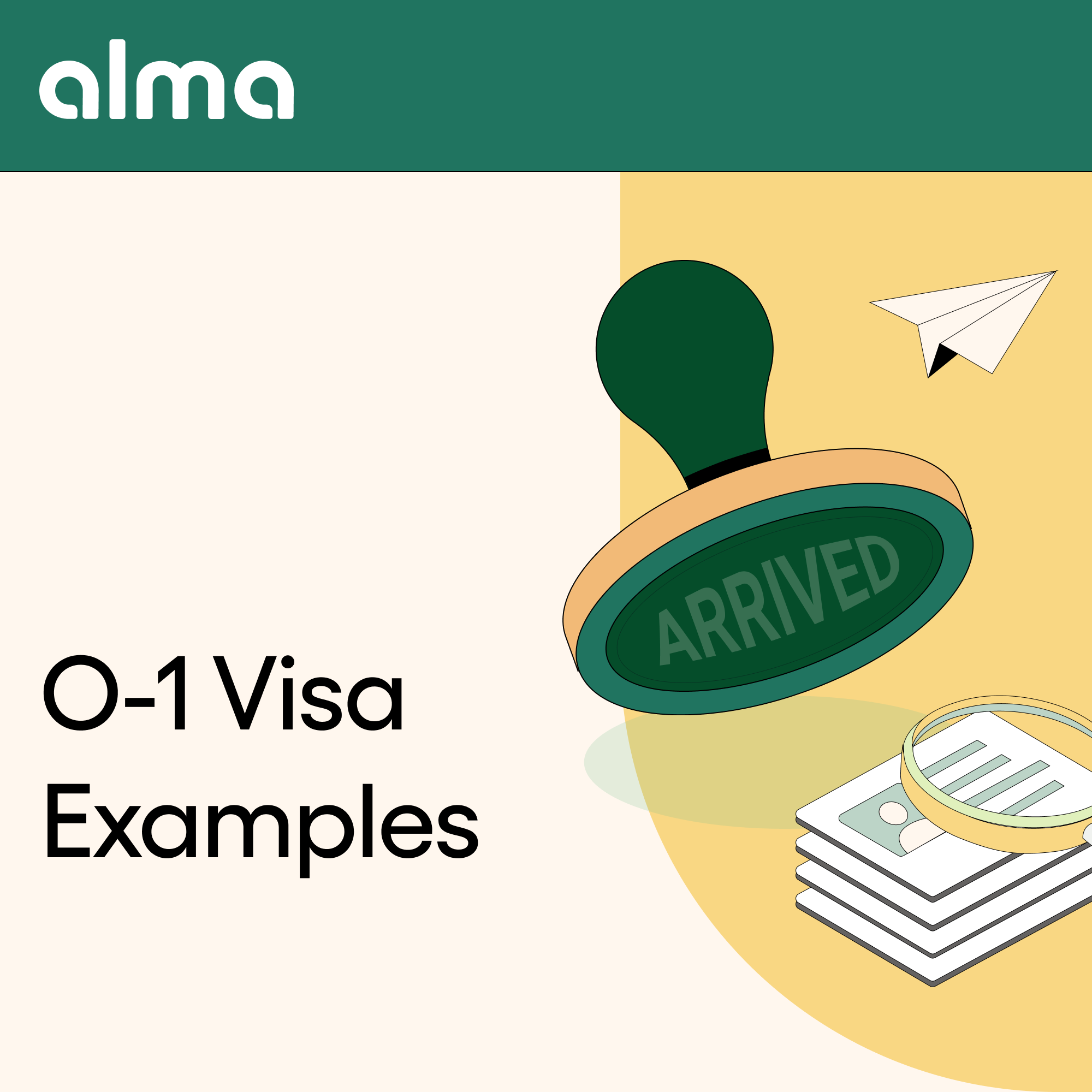- USCIS typically takes 4–6 months to process O-1 petitions, though timelines can vary based on workload and case complexity.
- USCIS Premium Processing cuts the review time to 15 business days for a $2,805 fee, but it doesn’t cover the time spent gathering documents or preparing the petition.
- The full O-1 journey — from confirming eligibility to collecting evidence, filing, and completing visa stamping — can take several months and varies by case.
- Alma streamlines the process with an average 2–3 week petition prep, a 99+% approval rate, and clear timelines, direct attorney access, and step-by-step support.
It generally takes 4–6 months for U.S. Citizenship and Immigration Services (USCIS) to process an O-1 visa, though actual timelines vary based on the service center’s workload, case complexity, and other factors.
You can also opt for USCIS Premium Processing, which shortens the review to 15 business days for a $2,805 fee.
Keep in mind that USCIS processing times reflect only the petition review stage, not the full O-1 visa process.
The entire process can take many months and typically involves:
- Collecting evidence of extraordinary ability, such as career achievements, industry recognition, or other supporting documentation.
- Organizing that evidence into a clear legal narrative that persuasively demonstrates to USCIS why the petition should be approved.
- Attending a visa interview at a U.S. embassy or consulate to get the O-1 visa stamp if you live abroad, or securing a change of status if you’re applying from within the U.S.
Since each stage has its own wait time and depends on factors beyond your control, the overall process can feel unpredictable. For many applicants, these steps add up to months of uncertainty.
That’s why Alma set out to make case preparation faster and more efficient: our accelerated process helps clients get a USCIS decision in about six weeks, with a 99+% approval rate.
Below, we outline O-1 visa timelines in detail and show how Alma makes each step more efficient.
Timelines and Steps for Getting an O-1 Visa
The O-1A and O-1B application process follows four key steps:
1. Determine Eligibility & Collect Supporting Evidence
First, you need to confirm that you meet USCIS’s standards for extraordinary ability:
- For the O-1A, this means showing distinction in business, science, education, or athletics by:
- Meeting at least three of eight regulatory criteria such as membership in organizations that require outstanding achievement.
- Having received a major, internationally recognized award, such as a Nobel Prize or Fields Medal.
- For the O-1B, you must demonstrate exceptional ability in the arts, motion picture, or television industries by:
- Meeting at least three of six criteria such as playing a leading role in a distinguished production or event.
You can gauge how well your profile fits USCIS’s eligibility criteria, but many applicants find it helpful to work with an experienced attorney who knows how to interpret those standards and apply them to a professional record.
USCIS standards are high and subjective, so the strength of your case depends not just on meeting the criteria, but on how convincingly your outstanding achievements are presented.
Once you’re deemed eligible, the next step is gathering the evidence of extraordinary ability needed to build a strong petition with a real chance of approval.
- For the O-1A visa, gather evidence like award certificates, acceptance letters or membership confirmations to top-tier accelerators like Y Combinator or Techstars, copies and URLs of scholarly articles and media coverage, letters of recommendation from experts in your field, salary slips, and other proof of extraordinary ability.
- For the O-1B visa, this includes items like show programs, playbills, press releases, film contracts, copies of reviews or critiques from major media outlets or respected experts, documentation of commercial or critically acclaimed success (such as box office receipts, sales figures, or high viewership ratings), and financial records like pay stubs or tax returns showing a high salary.
This process can be time consuming, as it involves:
- Figuring out which pieces of your professional history are relevant, like awards, scholarly articles, leadership roles, or major contributions to your field, and securing a peer group advisory letter.
- Organizing these according to USCIS’ eligibility criteria.
- Ensuring that every document submitted is a legitimate, verifiable artifact, such as certified copies or official records that USCIS will accept as credible evidence.
Working with an attorney is helpful, but it often leads to long back-and-forth email exchanges to request, clarify, and re-send documents — which is another reason why this phase can drag on.
To solve that, Alma provides an in-house customer platform where clients can securely upload all supporting documents and track their case status in one place.
We also give clients a detailed case questionnaire and checklist so they know exactly which documents to provide.
This approach dramatically speeds up evidence gathering, and clients get expert guidance from our attorneys — each with over 10 years of experience — rather than being routed to paralegals or assistants like many other firms.

You also need a U.S.-based sponsor (either an employer or a U.S.-based agent) to file your petition on your behalf:
- For startup founders applying for the O-1A, this often means forming a U.S. business entity (such as a C-Corp or LLC) and establishing a formal employer–employee relationship with it — typically through a board of directors that can oversee the founder's employment.
- For O-1B visa applicants, the sponsor can be a U.S. company or a qualified agent who represents you and files on your behalf.
2. Prepare & File the Petition (Two to Three Months)
The next step is assembling your application from all the evidence and supporting documents you've gathered.
During this phase, your attorney builds a legal narrative explaining why you qualify for the O-1 visa. A complete petition for this visa category often runs 500–700 pages and can take two to three months to prepare.
Alma’s turnaround time is two to three weeks, after which you receive a finalized Form I-129 petition that your sponsor files directly with USCIS.
Note that this filing must be submitted no more than six months before the intended start date of your professional activities in the United States.
3. O-1 Visa Processing and USCIS Wait Time (Four to Six Months)
Form I-129 currently has a $1,055 filing fee and generally takes four to six months for USCIS to process. This is why we encourage most clients to opt for Premium Processing, which guarantees a response within 15 business days for $2,805 (plus additional costs outlined in our O-1 visa cost guide).
During processing, the reviewing USCIS officer makes a subjective decision based on whether the evidence and supporting documents convincingly demonstrate the applicant's extraordinary ability.
After reviewing the petition, USCIS will issue one of three responses:
- Approval: If the petition is approved, USCIS sends a Form I-797 Approval Notice to the beneficiary confirming the decision. For applicants outside the U.S., this approval notice is required to schedule the visa interview at a consulate.
- Denial: If the petition is denied, USCIS issues Form I-797 Denial Notice.
- Request for Evidence (RFE): USCIS asks for additional information or clarification before making a final decision.
An RFE may be issued for a range of reasons — from insufficient evidence to USCIS needing an original document with an identifying watermark. Receiving an RFE isn’t a denial; it’s simply a request to fill in gaps and strengthen your application.
Applicants typically have up to 12 weeks to respond to an RFE. If you used Premium Processing, the 15-business-day clock pauses until USCIS receives your response. After that, USCIS must issue a final decision within 15 business days.
If your petition is approved, applicants already in the U.S. may begin full-time work under O-1 nonimmigrant status, as this approval confers employment authorization. Those outside the U.S. must schedule an interview at a U.S. embassy or consulate to receive the visa stamp.

4. Arrange an Interview at a U.S. Embassy or Consulate
To schedule an interview, you’ll submit the online visa application form (DS-160) and pay the application fee. You must bring your USCIS Form I-797 Approval Notice to the interview. Interview wait times vary by consulate and can change weekly.
At the interview, a consular officer will review your application and determine whether to issue the nonimmigrant visa. If approved, an O-1 visa stamp is placed in your passport so you can travel to the U.S. and activate your status to begin work.
Dependents of the O-1 beneficiary — unmarried children under 21 and a spouse — applying from outside the U.S. for O-3 visas must also complete consular processing. This can be done at the same time as the primary O-1 applicant's interview.
Cutting Down the Wait: Alma’s Approach
Our experienced attorneys have handled hundreds of successful O-1 cases and know how to identify the strongest criteria for your case, ensuring your petition is built on solid evidence.
- We regularly work with complex petitions, including startup founders and high achievers with unconventional profiles, helping frame their accomplishments in a way that aligns with USCIS standards and clearly demonstrates impact.
- Every applicant is invited to a 30-minute call where we review their profile and provide an expert opinion on their eligibility for the O-1 visa.
- Our efficient visa application process and client-led approach offer clear communication and fast turnaround times — typically two to three weeks after we receive your required documents — with a success rate of over 99%. This also includes coordinating the required peer group advisory letter, which must accompany the petition for most applicants.
- Each applicant works directly with an experienced attorney who is available to answer questions throughout the process.

If you’re considering the employment-based O-1 visa, Alma can help you determine your eligibility, gather the right evidence, and present your achievements in the strongest possible way — with steps toward permanent residence if that’s your goal. Book a free consultation to see if you qualify.
Frequently Asked Questions
You can see the status of your O-1 petition directly on the USCIS website:
- The USCIS Processing Times tool shows how long the U.S. government is currently taking to process cases like yours at the specific service center or field office handling your petition.
- If you already have a receipt notice (Form I-797C), you can track your individual case by entering your receipt number into the Case Status Online tool.
Not necessarily, as each nonimmigrant visa has its own benefits and trade-offs. The O-1 is unique among entrepreneur visas in its flexibility around employment structure, duration of stay, and potential to achieve permanent residence.
It’s designed for people who have demonstrated extraordinary ability or achievement in fields like science, education, business, sports, or the arts.
Applicants must show national or international recognition and prove they’re among the top in their field (often supported by indicators like a high salary).
The H-1B, by contrast, is for skilled professionals in specialty occupations like IT, engineering, finance, healthcare, and education. It requires a bachelor’s degree (or equivalent experience) and applies to a wide range of occupations.
Compared to the O-1, the H-1B is generally easier to qualify for and makes switching employers smoother — but it comes with its own constraints, including the annual cap and lottery.
Here are a few more differences between the two:
- No annual cap: The O-1 visa has no annual cap or lottery, so you can apply at any time. The H-1B visa, on the other hand, is capped at 85,000 spots per year and uses a lottery system to select applicants unless an exemption applies.
- Work flexibility: O-1 visa holders may work with multiple employers or take on freelance/part-time projects with the right sponsorship setup (as long as each petition properly establishes employment authorization). H-1B holders are tied to one employer and need approval for any job changes or side work.
- Duration of stay: O-1 visas are granted for up to three years of full-time employment and can be extended in one-year increments. In contrast, H-1B visas have a maximum limit of six years, after which the person usually must leave the U.S. for at least a year before applying again — unless they meet certain conditions that allow for one- or three-year extensions.
- Spouse work authorization: Spouses of H-1B holders (H-4 visas) can sometimes get employment authorization, while spouses of O-1 holders (O-3 visas) cannot work while in the U.S.
Yes, you’re allowed an initial stay of up to three years, but thereafter you can renew annually in one-year increments as long as you’re still actively engaged in the work that supports your O-1 status.
You can change jobs, but the rules are strict. Your original O-1 approval is tied to the specific employer, agent, or project listed in your petition. You can’t start working for a new employer until they file a new O-1 petition with U.S. Citizenship and Immigration Services and it gets approved.
If you lose your job or your employment ends while on the O-1, you have a 60-day grace period (or until your I-94 expires, whichever comes first) to find a new sponsor, file a new petition, apply for a change of status, or leave the U.S. Staying beyond that grace period without valid status can result in being considered unlawfully present.




.png)
.jpg)

